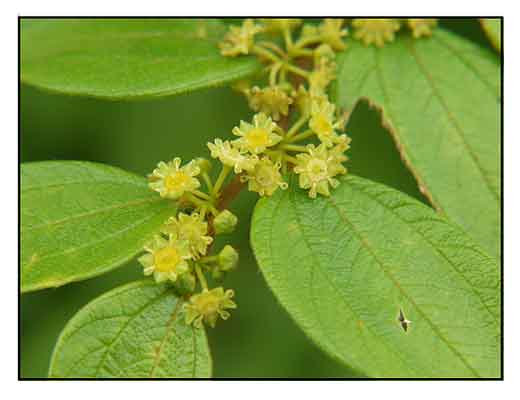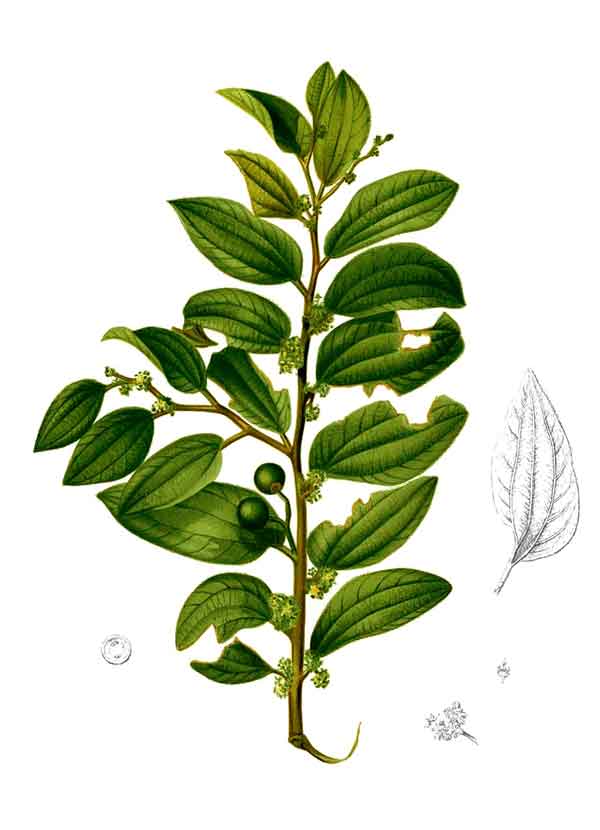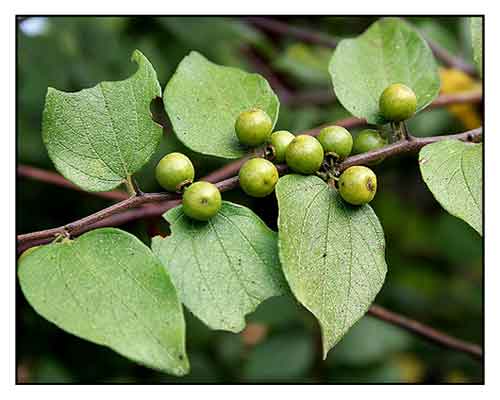 Gen info Gen info
- Ziziphus is a genus of about 40 species of spiny shrubs and small trees in the buckthorn family, Rhamnaceae, distributed in the warm-temperate, subtropical, and tropical regions of the world.
- Etymology: The genus name Ziziphus is Ancient Greek from the Persian word ziza for a plant name found in ancient Persia, referring to similarities between plants. The species epithet oenopolia also derives from Ancient Greek, Oenone for a beautiful mountain nymph, and Polia, which is Ancient Greek for pale gray. It may refer to the early love affair between Paris and Oenone. (4)
 Botany Botany
Ziziphus oenopolia is a shrub, erect or scandent, spinose. Young branches densely ferruginous or yellow-brown pubescent; bark gray or gray-brown. Stipular spines 1, sometimes 2, one recurved and one erect, 3-4 mm; petiole 5-7 mm, densely yellow-brown pubescent; leaf blade ovate-oblong or ovate-lanceolate, 3-8 × 2-4 cm, papery, abaxially appressed pubescent to nearly villous, adaxially veins sparsely pubescent or glabrescent, 3-veined at base, veins prominent abaxially, conspicuously impressed adaxially, base usually ± asymmetric, subrounded, margin inconspicuously crenate, apex acute or acuminate. Flowers greenish yellow, few to 10 in axillary shortly pedunculate cymes. Pedicel ca. 2 mm, pilose. Sepals ovate-triangular, abaxially sparsely pilose to pubescent, adaxially glabrous, apex acute. Petals spatulate, clawed, enfolding stamens. Stamens slightly shorter than petals. Disk pentagonous, thick, fleshy, often 5-lobed. Ovary globose, glabrous, immersed in disk; style 2-branched. Drupe black, shiny, globose or obovoid-globose, small, 5-7 × 5-6 mm, base with persistent calyx tube, apex mucronulate; fruiting pedicel 3-4 mm, pilose; endocarp cartilaginous, ca. 2 mm; stone 1- or 2-seeded. Seeds shiny, globose. (Flora of China) (3)
Distribution
- Native to the Philippines.
- Grows primarily in seasonally dry tropical biome.
(1)
- In light secondary forests, in thickets and hedges, and in savannas,
300m to 1000m altitude.
(2)
- Also native to Andaman Is., Assam, Bangladesh, Cambodia, China, India, Laos, Lesser Sunda Is., Malaya, Myanmar, Nepal, New Gu8inea, Northern Territory, Queensland, Sri Lanka, Thailand, Vietnam.
(1)
 Constituents Constituents
- Phytochemical analysis of crude extracts yielded carbohydrates, alkaloids, phenolic compounds, tannins, and saponins. (see study below) (6)
- Phytochemical screening of stem bark yielded glycosides, flavonoids, alkaloids, and terpenoids in the ethanol extract and flavonoids, carbohydrates, and proteins in the aqueous extracts of Z. oenoplia. (see study below) (10)
- Study of ethanol extract of fruit yielded total flavonoid content of 69 µg/mg catechin equivalent. H PTLC confirmed the presence of quercetin. GC-MS analysis showed a total of 16 compounds of 87.66% with quinic acid as the major compound (22.29%). (see study below) (13)
- Methanol extract of roots revealed presence of saponins, flavonoids, glycosides, alkaloids, tannins, and reducing sugars. (see study below)
(14)
- GC-MS analysis of seed extract showed 24 major peaks revealing 16 major phytochemical compounds. FTIR analysis confirmed the presence of alcohols, aromatic compound, alkanes, aldehydes, ketones, alkenes, amines, amides, nitro compounds, carboxylic acids, ethers, and ester.
Qualitative analysis yielded alkaloids, flavonoids, glycosides, phenols, saponins, steroids, tannins, quinones, terpenoids, with absence of protein and amino acid. (see study below) (15)
- Phytochemical study of methanol extract of leaves yielded
substantial amount of phenols (57.33 mg). flavonoids (116.19 mg), flavonol (59.77 mg) and condensed tannins (287.85 mg) content. (see study below) (20)
Properties
- Studies have suggested antibacterial, anti-denaturation, hepatoprotective, hypoglycemic, hypolipidemic, antioxidant, immunomodulatory, wound healing, anthelmintic properties.
Parts used
Leaves, roots, stem bark.
Uses
Edibility
- Berries are edible.
Folkloric
- Bark used for wound healing and stomachache. Roots used for hyperacidity and Ascaris infection.
(2)
- In Cambodia, ingredient in a polyherbal root decoction
use for postpartum care.
- In Assam, used for treatment of diarrhea and dysentery.
- In Uttar Pradesh, used for liver diseases. Among the Munda tribe, used as ingredient in the preparation of stomach ache pills. In Ayurveda, used for treatment ulcers, stomach aches, obesity, asthma, and as astringent, digestive, antiseptic, hepatoprotective, wound healing and diuretic. (5)
- Konkani peoples of Maharashtra use leaves as dressing for wounds. In Burma, stem barks used as mouthwash for sore throats, dysentery, and inflammation of the uterus. (5)
- Decoction of root bark used to promote healing of fresh wounds.
Others
- Tannin: Bark yields tannin, not very high at about 12%, making it suitable for direct use in tannery. Used in India for tanning hides into leather. (2)
- Wood: Used for fences. Also as fuelwood.
Studies
• Antibacterial / Anti-Denaturation: Study evaluated the antidenaturation and antibacterial activities of various extracts of Z. oenoplia. All extracts of Z. oenoplia protected Bovine Serum Albumin (BSA) from denaturation more than 97% at 1 µg/ml concentration. Only the ethanol extract showed antibacterial activity against Staphylococcus aureus. (see constituents above) (6)
• Hepatoprotective / Hepatotoxicity Induced by Antitubercular Drugs / Roots: Study evaluated the hepatoprotective potential of ethanolic (50%) extract of Ziziphus oenoplia (L.) Mill root against isoniazid (INH) and rifampicin (RIF) induced liver damage in animal models. The considerably elevated serum enzymatic activities of SGOT, SGPT, ALP, and bilirubin due to INH and RIF treatment were restored towards normal in a dose dependent manner after treatment with Z. oenoplia roots. Decreased activities of superoxide dismutase, catalase, glutathione S-transferase and glutathione peroxidase were restored towards normal dose dependently. The extract prevented elevation of hepatic malondialdehyde formation. Results indicated the ethanolic extract has potent hepatoprotective action against INH + RIF induced hepatic damage in rats. (7)
• Angiogenic Potential / Roots: Study evaluated the angiogenic potential of an ethanolic extract of Z. oenoplia root in an invitro chick chorioallantoic membrane (CAM) model. The extract increased the number of capillaries on the treated CAM surfaces 9-day old fertilized chick eggs. Results suggest the root extract possesses significant angiogenic potential, which may be beneficial for wound healing. (8)
• Silver Nanoparticles / Antibacteria / Leaves: Study reports on the synthesis of silver nanoparticles using aqueous leaf extract of Ziziphus oenoplia, which act as both reducing and capping agent. The AgNPs exhibited high antibacterial activity when tested against four bacterial strains: K. pneumonia, P. aeruginosa, E. coli, and S. typhi. The presence of AgNPs were observed near the cell membrane of the bacteria 30 min after exposure and bacterial lysis was completed at 24 hr, which provide insight on the mechanism of bacterial lysis by direct damage to the cell membrane. (9)
• Antidiabetic / Hypolipidemic / Stem Barks: Study evaluated the hypoglycemic and hypolipidemic effects of ethanolic and aqueous extracts of Z. oenoplia stem bark against alloxan induced hyperglycemic rats. Oral administration of the extracts showed significant (p<0.05) antihyperglycemic activity in a dose dependent manner. The diabetic rats showed significant (p<0.01) reduction in blood glucose, serum liver enzymes, and lipid profile compared to normal rats. Significant effects of aqueous and alcoholic extracts in alpha amylase and alpha glucosidase activity were observed. The antidiabetic effect may be due to the presence of flavonoid constituents. (see constituents above) (10)
• Hypoglycemic / Antioxidant / Fruit: Study evaluated in vitro free radical scavenging and hypoglycemic effect of ethanol extracts and solvent fractions of Z. oenoplia fruit. Maximum antioxidant activity by DPPH radical scavenging assay was exhibited by the ethanol crude extract (87.66% inhibition) with IC50 of 2.72 followed by the chloroform fraction, compared to standard ascorbic acid at 90.72% inhibition and IC50 of 1.33. The ethanol crude extract also showed maximum α-glucosidase and α-amylase inhibitory effect at 85.2 and 88.43% at 800 µg/mL respectively, compared to reference drug acarbose at 97.2 and 99.12% respectively. Results suggest the traditional claim as antioxidant and hypoglycemic has scientific background. (11)
• Lectin / ZOSL / Immunomodulatory / Seeds: Study evaluated the most active lectins isolated from seeds of Z. oenoplia. The lectin was named ZOSL (Ziziphus oenopia seed lectin) and was tested for anti-allergic and anti-inflammatory activity in vivo through Arthus reaction and anaphylactic shock on Wistar albino rats. Results showed oral administration to Wistar rats can prevent anaphylactic shock as well as the Arthus reaction. (12)
• Antioxidant / Cytotoxic / Immunomodulatory / Seeds: Study evaluated the antioxidant, cytotoxic, and inducible nitric oxide synthase (iNOS) gene downregulation activities of Z. oenoplia fruit. Free radical scavenging of the fruit extract ranged from 160-12 to 650.23 µg/mL. The extract exhibited significant hepatoprotectiion and reverse transcriptase polymerase (RT-PCR) analysis showed down-regulation of iNOS gene expression in hepatocytes at transcriptional level. SOF showed significant cytotoxicity and propidium iodide staining confirmed the induction of apoptosis in cervical cancer cells (HeLa). (see constituents above) (13)
• Antidiarrheal / Root: Study evaluated the potential antidiarrheal activity of methanolic extract of Z. eonoplia root in experimental diarrhea induced by castor oil and magnesium sulphate in rat at 200 and 400 mg/kbw orally. Results showed significant antidiarrheal activity, which supports the traditional use of the plant to cure diarrhea. (see constituents above) (14)
• Antimicrobial / Seeds: Study of seed extract of Z. oenoplia showed antimicrobial activity against tested microbes: S. typhi, S. aureus, and E. coli. (see constituents above) (15)
• Hypolipidemic / Leaves: Study evaluated the hypolipidemic activity of ethanolic extract of Ziziphus oenoplia leaves in induced hyperlipidemia and use of atherogenic diet (cholesterol 2%, cholic acid 1%, and coconut oil 2%) along with standard rat chow diet in Wistar albino rats. Results showed significant hypolipidemic activity (p<0.01) by reduction of serum cholesterol, LDL, VLDL, AI, LDL-C/HDL-C ratio and increase in HDL. Histopathological exam showed decreased atheromatous plaque size and inflammatory changes. Hypolipidemic and antiatherosclerotic effects may be due to the presence of alkaloids, flavonoids, and phenolic compounds. (16)
• Wound Healing / Anti-Inflammatory / Leaves: Study evaluated the wound healing activity of aqueous and alcoholic extracts of ZO leaves on excision and incision wound models in rats using topical application of 5% w/w/ ointment with PEG as ointment base. Results showed significant decrease in epithelization time and significant increase in tensile strength. While both extracts exhibited significant wound healing activity, more significant activity was shown by the alcoholic extract. (17)
• Hepatoprotective / Paracetamol Induced Toxicity / Roots: Study evaluated the hepatoprotective potential of ethyl acetate fraction of ZO roots against paracetamol induced hepatotoxicity in Wistar albino rats. The significantly high activities of serum enzymes and bilirubin due to paracetamol were restored to normal in a dose-dependent manner, along with restoration of reduced activities of glutathione S-transferase and glutathione reductase. Results suggest effective hepatoprotective action. (18)
• Biosorption of Victoria Blue / Seeds: Study predicts the feasibility for the adsorptive removal of Victoria Blue dye (VB dye) from aqueous solution using low cost biosorbent Z. oenoplia seeds. (19)
• Anthelmintic / Antioxidant / Cytotoxic / Leaves: Study of methanol extract of leaves showed strong antioxidant activity in DPPH radical scavenging, ferric reducing power, and total antioxidant capacity assays. Extract showed significant anthelmintic potentials against aquarium wormTubifex tubifex, and low cytotoxic activity by brine shrimp lethality assay. The significant activities may be due to the presence of high polyphenol contents and one bioactive phytocompound, Zizyphine F, found most effective in the molecular docking study. (see constituents above) (20)
• Herbal Shampoo / Leaves: Study reports on the formulation of a self preserving shampoo using Ziziphus oenoplia leaves. Three different herbal shampoos were formulated containing dissimilar amounts of Z. oenoplia with sodium laureth sulfate as surfactant, using parameters of surface tension reduction, stable foam, wetting effect, good cleansing, and pseudo plastic rheological actions. Foam volume was on par and formulas showed higher detergency and foaming effects than commercial herbal one (p<0.05), and considered safe for children due to absence of high chemical contents. (21)
• Analgesic / Antinociceptive Activity / Leaves: Study evaluated the analgesic and antinociceptive activity of hydroalcoholic extract of Z. oenoplia leaves. Acetic acid induced writhing, Eddy's hot plate, and Tail flick models were used for analgesic study, while tail immersion model was used for anti-nociceptive study. Results showed promising analgesic and anti-nociceptive properties, which are probably peripherally mediated via prostaglandin inhibition as well as central inhibitory mechanism. (22)
• Antibacterial / Antibiotic Resistant Pseudomonas Strains / Leaves: Study evaluated the bactericidal potential of different leaf extracts of Blepharis maderaspatensis and Ziziphus oenoplia against multidrug resistant bacterial strains from pus specimens. Of bacterial isolates, P. aeruginosa CM1-CM4 showed extensive tolerance to various commercial antibiotics. In a combined approach, methanol extracts of BM and ZO were more effective than individual and other solvent extracts against P. aeruginosa CM1-CM4 strains. (23)
Availability
Wild-crafted.
|

![]()




 Botany
Botany
